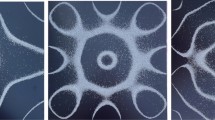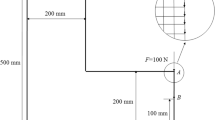Abstract
Optimizing eigenvalues of biharmonic equations appears in the frequency control based on density distribution of composite rods and thin plates with clamped or simply supported boundary conditions. In this paper, we use a rearrangement algorithm to find the optimal density distribution which minimizes a specific eigenvalue. We answer the open question regarding optimal density configurations to minimize k-th eigenvalue for clamped rods and analytically show that the optimal configurations are distinct for clamped rods and simply supported rods. Many numerical simulations in both one and two dimensions demonstrate the robustness and efficiency of the proposed approach.













Similar content being viewed by others
References
Anedda, C., Cuccu, F., Porru, G.: Minimization of the first eigenvalue in problems involving the bi-Laplacian. Revista de Matemática: Teoría y Aplicaciones 16(1), 127–136 (2009)
Ashbaugh, M.S., Benguria, R.D., et al.: On rayleigh’s conjecture for the clamped plate and its generalization to three dimensions. Duke Math. J. 78(1), 1–18 (1995)
Banks, D.O.: Bounds for the eigenvalues of some vibrating systems. Pac. J. Math. 10(2), 439–474 (1960)
Banks, D.O.: Bounds for the eigenvalues of nonhomogeneous hinged vibrating rods. J. Math. Mech. 16, 949–966 (1967)
Beesack, P.R.: Isoperimetric inequalities for the nonhomogeneous clamped rod and plate. J. Math. Mech. 8, 471–482 (1959)
Belgacem, F.: Elliptic Boundary Value Problems with Indefinite Weights, Variational Formulations of the Principal Eigenvalue, and Applications, vol. 368. CRC Press, Boca Raton (1997)
Bendali, A., Fares, M., Tizaoui, A., Tordeux, S.: Matched asymptotic expansions of the eigenvalues of a 3-d boundary-value problem relative to two cavities linked by a hole of small size. CICP (2012)
Bjørstad, P.E., Tjøstheim, B.P.: High precision solutions of two fourth order eigenvalue problems. Computing 63(2), 97–107 (1999)
Brown, B.M. , Davies, E.B., Jimack, P.K., Mihajlovi’c, M.D.: On the Accurate Finite Element Solution of a Class of Fourth Order Eigenvalue Problems. arXiv preprint arXiv:math/9905038 (1999)
Buoso, D., Lamberti, P.D.: Shape deformation for vibrating hinged plates. Math. Methods. Appl. Sci. 37(2), 237–244 (2014)
Cadeddu, L., Farina, M.A., Porru, G.: Optimization of the principal eigenvalue under mixed boundary condition. Electron. J. Differ. Equ. 2014(154), 1–17 (2014)
Chanillo, S., Grieser, D., Imai, M., Kurata, K., Ohnishi, I.: Symmetry breaking and other phenomena in the optimization of eigenvalues for composite membranes. Commun. Math. Phys. 214(2), 315–337 (2000)
Chen, W., Diest, K., Kao, C.-Y., Marthaler, D.E., Sweatlock, L.A., Osher, S.: Gradient based optimization methods for metamaterial design. In: Diest, K. (ed.) Numerical Methods for Metamaterial Design, pp 175–204. Springer, Netherlands (2013)
Coffman, C.V., Duffin, R.J.: On the fundamental eigenfunctions of a clamped punctured disk. Adv. Appl. Math. 13(2), 142–151 (1992)
Cox, S.J.: The two phase drum with the deepest bass note. Jpn. J. Ind. Appl. Math. 8(3), 345–355 (1991)
Cox, S.J., Dobson, D.C.: Band structure optimization of two-dimensional photonic crystals in H-polarization. J. Comput. Phys. 158(2), 214–224 (2000)
Cuccu, F., Emamizadeh, B., Porru, G.: Optimization of the first eigenvalue in problems involving the bi-Laplacian. Proc. Am. Math. Soc. 137(5), 1677–1687 (2009)
Cuccu, F., Porru, G.: Maximization of the first eigenvalue in problems involving the bi-Laplacian. Nonlinear Anal. Theory Methods Appl. 71(12), e800–e809 (2009)
Dobson, D.C., Cox, S.J.: Maximizing band gaps in two-dimensional photonic crystals. SIAM J. Appl. Math. 59(6), 2108–2120 (1999)
He, L., Kao, C.-Y., Osher, S.: Incorporating topological derivatives into shape derivatives based level set methods. J. Comput. Phys. 225(1), 891–909 (2007)
Henrot, A.: Extremum Problems for Eigenvalues of Elliptic Operators. Springer, Berlin (2006)
Hintermüller, M., Kao, C.-Y., Laurain, A.: Principal eigenvalue minimization for an elliptic problem with indefinite weight and robin boundary conditions. Appl. Math. Optim. 65(1), 111–146 (2012)
Hunter, J.K.: Asymptotic Analysis and Singular Perturbation Theory. Department of Mathematics, University of California at Davis (2004)
Kao, C.-Y., Lou, Y., Yanagida, E.: Principal eigenvalue for an elliptic problem with indefinite weight on cylindrical domains. Math. Biosci. Eng 5(2), 315–335 (2008)
Kao, C.-Y., Osher, S., Yablonovitch, E.: Maximizing band gaps in two-dimensional photonic crystals by using level set methods. Appl. Phys. B Lasers Opt. 81(2), 235–244 (2005)
Kao, C.-Y., Santosa, F.: Maximization of the quality factor of an optical resonator. Wave Motion 45(4), 412–427 (2008)
Kao, C.-Y., Shu, S.: Efficient rearrangement algorithms for shape optimization on elliptic eigenvalue problems. J. Sci. Comput. 54(2–3), 492–512 (2013)
Karabash, I.M.: Nonlinear eigenvalue problem for optimal resonances in optical cavities. Math. Model. Nat. Phenom. 8(01), 143–155 (2013)
Krein, M.G.: On Certain Problems on the Maximum and Minimum of Characteristic Values and on the Lyapunov Zones of Stability. American Mathematical Society Translations. American Mathematical Society (1955)
Lehoucq, R.B., Sorensen, D.C., Yang, C.: ARPACK Users Guide: Solution of Large-Scale Eigenvalue Problems with Implicitly Restarted Arnoldi Methods, vol. 6. SIAM, Philadelphia, PA (1998)
Lin, J., Santosa, F.: Resonances of a finite one-dimensional photonic crystal with a defect. SIAM J. Appl. Math. 73(2), 1002–1019 (2013)
Lou, Y., Yanagida, E.: Minimization of the principal eigenvalue for an elliptic boundary value problem with indefinite weight, and applications to population dynamics. Jpn. J. Ind. Appl. Math. 23(3), 275–292 (2006)
Maksimović, M., Manfred Hammer, E.W.C., van Groesen, B.: Coupled optical defect microcavities in one-dimensional photonic crystals and quasi-normal modes. Opt. Eng. 47(11), 114601–114601 (2008)
Men, H., Lee, K.Y.K., Freund, R.M., Peraire, J., Johnson, S.G.: Robust topology optimization of three-dimensional photonic-crystal band-gap structures. Opt. Express 22(19), 22632–22648 (2014)
Men, H., Nguyen, N.-C., Freund, R.M., Lim, K.-M., Parrilo, P.A., Peraire, J.: Design of photonic crystals with multiple and combined band gaps. Phys. Rev. E 83(4), 046703 (2011)
Mohammadi, S.A., Bahrami, F.: Extremal principal eigenvalue of the bi-Laplacian operator. Appl. Math. Model. 40(3), 2291–2300 (2016)
Mohr, E.: Über die rayleighsche vermutung: Unter allen platten von gegebener fläche und konstanter dichte und elastizität hat die kreisförmige den tiefsten grundton. Annali di matematica pura ed applicata 104(1), 85–122 (1975)
Nadirashvili, N.S.: Rayleigh’s conjecture on the principal frequency of the clamped plate. Arch. Ration. Mech. Anal. 129(1), 1–10 (1995)
Osher, S.J., Santosa, F.: Level set methods for optimization problems involving geometry and constraints: I. Frequencies of a two-density inhomogeneous drum. J. Comput. Phys. 171(1), 272–288 (2001)
Osting, B.: Bragg structure and the first spectral gap. Appl. Math. Lett. 25(11), 1926–1930 (2012)
Rayleigh, J.W.S.: The Theory of Sound, vol. 1. McMillan, New York (1945)
Schwarz, B.: Some results on the frequencies of nonhomogeneous rods. J. Math. Anal. Appl. 5(2), 169–175 (1962)
Sigmund, O., Hougaard, K.: Geometric properties of optimal photonic crystals. Phys. Rev. Lett. 100(15), 153904 (2008)
Sweers, G.: When is the first eigenfunction for the clamped plate equation of fixed sign. Electron. J. Differ. Equ. Conf. 6, 285–296 (2001)
Szegö, G.: On membranes and plates. Proc. Natl. Acad. Sci. USA 36(3), 210 (1950)
Talenti, G.: On the first eigenvalue of the clamped plate. Ann. Mat. 129(1), 265–280 (1981)
Wayne, A.: Inequalities and inversions of order. Scr. Math. 12(2), 164–169 (1946)
Yolcu, S.Y., Yolcu, T.: Estimates on the eigenvalues of the clamped plate problem on domains in Euclidean spaces. J. Math. Phys. 54(4), 043515 (2013)
Author information
Authors and Affiliations
Corresponding author
Additional information
Ching-Shan Chou: This author is supported by NSF DMS1253481, Chiu-Yen Kao: This author is partially supported by NSF DMS1318364.
Appendices
Appendix 1
In one dimension, for simplicity, we choose \(D=[-1,1]\), and define a uniform grid of points \(x_{i}=-1+ih\) where h is the mesh size, \(0\le i\le N\) and \(N=2/h.\) The discretized eigenfunction is denoted by U in the form of a column vector \(\left( U_{0},\ldots ,U_{N}\right) ^{T}\). We approximate the fourth order derivative at \(x_{i}\) by the central difference formula
for \(i=2,\cdots ,N-2\). To approximate the derivatives at \(x_{1}\) and \(x_{N-1}\), values at ghost points \(x_{-1}=-1-h\) and \(x_{N+1}=1+h\) are necessary and can be obtained by the given boundary conditions. If clamped boundary conditions are imposed, that is,
we choose \(U_{0}=U_{N}=0\) at two end points and \(U_{-1}=U_{1}\) and \(U_{N+1}=U_{N-1}\) at two ghost points. Thus
and
The hinged boundary conditions
lead to \(U_{0}=U_{N}=0\) at the boundaries, \(U_{-1}=2U_{0}-U_{1}\) and \(U_{N+1}=2U_{N}-U_{N-1}\) at two ghost points. Thus
and
Consequently, the matrix representing the biharmonic operator on \([-1,1]\) is formed by assigning the coefficients in the approximation formula of \(U_{i}^{''''}\) to the i-th row.
Appendix 2
In two-dimensional rectangle \(D=[-a,a]\times [-b,b]\), define a uniform grid of points \(x_{i,j}=(x_{1i},x_{2j})\) where \(x_{1i}=-a+ih_{1}, x_{2j}=-b+jh_{2}\) where \(h_{1}\) and \(h_{2}\) are mesh sizes in \(x_{1}\)- and \(x_{2}\)- directions, respectively. For simplicity, we assume that \(h_{1}=h_{2}=h\). Let \(\left( U_{i,j}\right) _{0\le i\le N,0\le j\le M}\) be the matrix of the discretized eigenfunction. The second order central difference scheme involving 13-point stencils is used to approximate the biharmonic operator
for \(2\le i\le N-2\), and \(2\le j\le M-2\). With clamped boundary conditions the biharmonic operator along \(i=1\) is approximated by
and
The approximating formulas along \(i=N-1, j=1\) or \(j=M-1\) can be derived similarly. All points at the boundaries are taken as zero, \(U_{0,j}=U_{N,j}=U_{i,0}=U_{i,M}=0.\) For the hinged boundary conditions, the discretization is almost the same, except the approximations for points near the boundaries (\(i=1\) or \(N-1, j=1\) or \(M-1\)). For example,
and
The discretization along the other sides can be obtained similarly. Each stencil approximating \(\Delta ^{2}U_{i,j}\) is assigned into a row to form the matrix of the discrete biharmonic operator. Therefore, the size of the matrix to approximate the biharmonic operator on a rectangle is \((N-1)(M-1)\times (N-1)(M-1)\).
Appendix 3
For the biharmonic eigenvalue problem on a circular or annular domain, we perform the numerical discretization after transforming the problem into the polar coordinates, and the harmonic operator in terms of \((r,\theta )\) is
Assume the domain \(\Omega \) is a disc with radius one, denoted by D(0, 1). In polar coordinates \((r,\theta )\), the mesh is set to be \(r_{i}=\frac{2i-1}{2N+1}, \theta _{j}=\frac{2\pi j}{M}, i=1,2,\ldots ,N+1, j=1,2,\ldots ,M\) to avoid \(\left( 0,0\right) \). Suppose \(U_{(N+1)\times M}\) is the matrix of discretized eigenfunction, then
Near the center, the ghost point \(U_{0,j}\) satisfies
For clamped boundary conditions, we can define ghost points outside \(r=1\) as
The simply supported boundary conditions in terms of polar coordinates are written as
where \(\nu \) is a given constant. Thus we can define
as the ghost points outside \(r=1\). Let L be the discrete operator \(\Delta \) with clamped or simply supported boundary conditions, then the biharmonic operator is approximated by \(L^{2}\) after eliminating the last M rows and columns corresponding to the boundary.
The discretization on an annular domain with an inner radius \(r_{in}\) and an outer radius \(r_{out}\) is similar to the circular case, except that the origin is not included in the domain and therefore the discretized mesh starts at \(r_{in}\) and ends at \(r_{out}\) in the r-direction . An annulus has both inner and outer boundaries, and therefore \(L^{2}\) is obtained by deleting the first and last N rows and columns from the discrete version of the biharmonic operator with clamped or simply supported boundary conditions.
Rights and permissions
About this article
Cite this article
Chen, W., Chou, CS. & Kao, CY. Minimizing Eigenvalues for Inhomogeneous Rods and Plates. J Sci Comput 69, 983–1013 (2016). https://doi.org/10.1007/s10915-016-0222-9
Received:
Revised:
Accepted:
Published:
Issue Date:
DOI: https://doi.org/10.1007/s10915-016-0222-9




